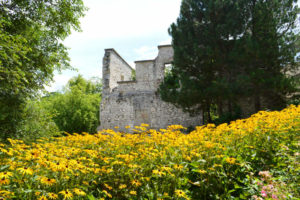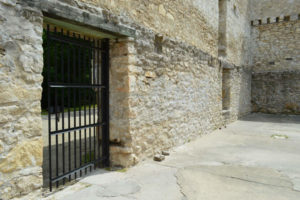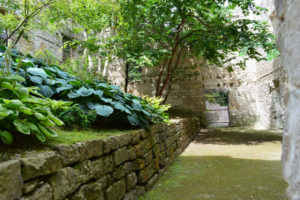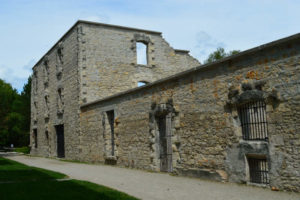Goldie Mill ruins
Goldie Mill is located in Goldie Mill Park at the northeast corner of Cardigan and Norwich streets and on the west bank of the Speed River in the city of Guelph. This three-storey limestone building, now a ruin, was constructed in 1866.
Goldie Mill on Canada’s Historic Places website
Goldie Mill was designated, by the City of Guelph, for its historic and architectural value under Part IV of the Ontario Heritage Act (By-law (1983)-11323).
Heritage value
The former Goldie Mill site is one of the most historic manufacturing locations in Guelph. In 1827, David Gilkison, a cousin of Guelph’s founder John Galt, built a sawmill beside the Speed River. In 1845, doctors W. Clarke and H. Orton built the “Wellington Mills.” Shortly after a fire in 1850, the mills were rebuilt in stone and renamed the “People’s Mills.” After another fire, in 1864, the land was purchased by James Goldie, who enlarged and rebuilt the stone building, in 1866. As the owner of Goldie Mill, James was considered one of the leading flour manufacturers and dealers in Ontario, and served as president of the Ontario Millers’ Association.
The flour mills continued to expand and flourish under the direction of the Goldie family until sold in 1918. The mill continued to be operated until a spring flood in 1929 carried away the dam. A fire in 1953 completely destroyed the building, and it is now maintained as a ruin by the Grand River Conservation Authority.
In the 19th century, the manufacturing complex included a foundry, sawmill, cooperage, distillery, piggery and tannery. The diverse and long-time use of Goldie Mill contributed significantly to the growth and prosperity of Guelph. The mill has been characterized as a model flour mill in Canada.
Among the unique architectural features of the masonry construction of the thick stone walls are double-reinforced stone lintels, an unusual type of construction in Ontario. The most impressive remaining section of the structure was built in 1867 with quarry-faced limestone. All stone was quarried on the mill property.
The heritage designation covers all masonry construction, which survives after the 1983 stabilization project, the 90-foot brick chimney as well as the surrounding property as purchased by Grand River Conservation Authority in March 1976.
Legal description
Part of the Mill Lands on Cardigan Street and Part of the original bed of the River Speed, in the Canada Company’s Survey of the Town, now City of Guelph, and which may be also known as part of the Saw Mill Lot in Divisions “A” and “F”.
Designated portions
- The three-storey stone walls of the north-westerly section
- The two-storey stone walls of the Elevator Building (middle section)
- The brick chimney
- The riverside wall including ruins of the boiler room windows.
The remainder of the property is designated to include:
- Foundations which are buried to the north and northwest of the ruins
- River willows along the riverbank of the property
- Retention of other trees on the property is not required under this designation.




